Building the Soil: What We’re Starting With
On left, soil of the new garden. On right, soil from the original garden (after 10 years of care).
The hardest part of leaving our garden was leaving the soil that we cared for and built up over 10 years.
Tons of compost, compost tea, organic fertilizer and love were put into the soil and it showed it - plants thrived, the soil looked rich and soil tests showed improvement on all things especially the increase of organic matter (which is dead plant matter - and is also mostly carbon). The new soil has its challenges. The first thing we did in the fall was take a soil sample and get it tested.
The soil test found that the new soil has a strangely low PH (5.3) and is also low in calcium, magnesium, potassium, nitrogen and zinc. Based on recommendations of organic soil amendments from Harmony Farm Supply, we will be adding quite a few organic fertilizers to the soil to raise the level of many nutrients and also change the PH to one that is closer to what vegetables like (closer to 6.8). We will begin the long process of building soil.
We are amending the vegetable beds with about 15 yards of homemade compost from last year’s food and garden waste. The perennial beds are getting a nice layer of compost from Grab ‘n’ Grow (thank you for your generous donation!) and also a layer of arbor mulch, which is shredded wood that has started to decompose.
The first bed of kale that was planted in the ground is up (above) and we will start harvesting this week. I was worried when we stuck it in the ground because there was a chance it would not thrive but it is dark green and healthy! There is hope for a big vibrant garden this year.
The long term hope is to not be using tons of soil amendments. As we build the soil microbial life through compost additions and compost tea and soil care (less tilling and more mulching), the microorganisms will help us utilize the nutrients in the soil. One of our Santa Rosa garden mentors, Melissa, came by to get a soil sample to test for the microbial life in the original soil. She is a student of the Soil Food Web and has a microscope to see what is in the soil. We want to start with a baseline and then test through the years to see if we increase and support the microorganisms. I will be interested in what she finds - more to report in the future.
We believe that healthy soil is the only way to have healthy food.
There are studies out that show a 60 percent decrease in the nutrition of fruits and vegetables in the last 60 years. That is mostly because of our lack of care of the soil. Our hope is to grow nutritionally dense food so each bite nourishes our clients to its fullest. We are starting over but are committed to once again build rich soil and care for it over the long haul. Soil health, human health and planet health are intertwined and at the core of our work at Ceres.




